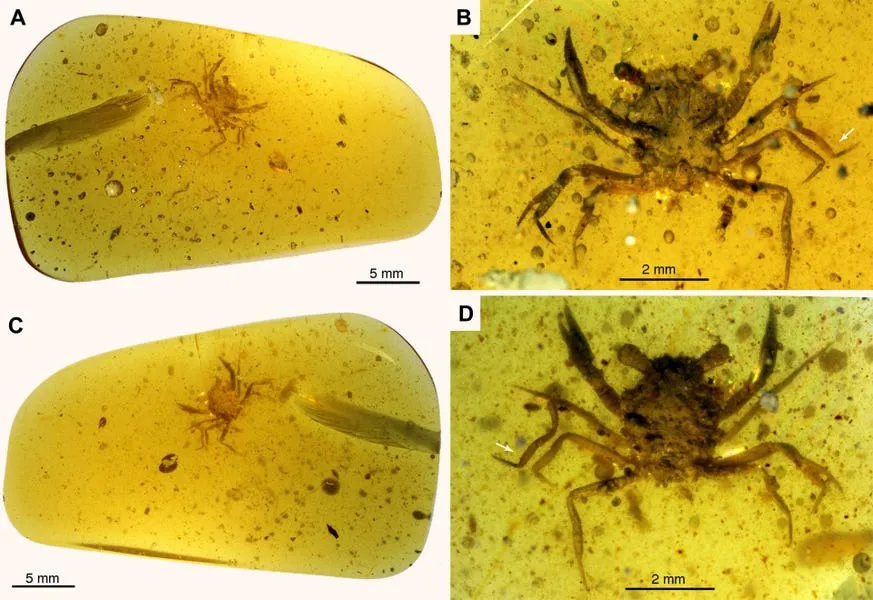If a scientist used the word "zombie" to describe a fossil, know that they aren't trying to be poetic. Usually, they mean that it looks so fresh and intact that it could easily have stepped straight out of the past. This is precisely the case with Cretapsara athanata: a crab fossilized in Burmese amber 100 million years ago, during the age of the dinosaurs.
What makes Cretapsara so intriguing is that, for decades, scientists believed that fully amphibious "true crabs" didn't appear until much later in Earth's history. Similarly, they believed that early crab evolution was to be strictly marine; any claim otherwise bordered on speculation.
Then this tiny, amber-entombed crustacean appeared.
The fossil was formally described in a 2021 study published in Science Advances, by researcher Javier Luque and his colleagues. After conducting micro-CT scans on the specimen, they discovered a crab preserved so flawlessly that it was unlike anything ever seen before. Astonishingly, its legs, claws, antennae, compound eyes and delicate mouthparts were all still intact.
It's worth noting that crabs almost never fossilize well. Their exoskeletons fall apart quickly, and soft tissue preservation is nearly impossible. This is precisely why Luque and his colleagues were so surprised by Cretapsara.
Evidently, amber made this much easier. As sticky resin flowed from ancient trees, it trapped organisms rapidly. In turn, they're sealed off from decay indefinitely. However, there's little reason for a crab to encounter tree resin, given that they're marine creatures; resin flows on land.
This is what made the idea of a modern-looking brachyuran crab preserved in amber once seem biologically impossible. Yet the fossil was unmistakably real. It was lifelike, intact and surprisingly advanced for its age.
Cretapsara was just a mere 2-3 millimeters long, which made it more than small enough to easily become ensnared in tree resin. However, despite its small size, its limbs and sensory structures suggested unexpected sophistication.
Eventually, the researchers named it Cretapsara athanata -- meaning "the immortal spirit of the clouds and waters."
Crab evolution is complicated. As 2017 research from Biological Journal of the Linnean Society explains, this is because the group has undergone "carcinization." This refers to the various different ways that the evolution of crab-like forms has repeated across different lineages. Because of this process, scientists came to agree that amphibious or semi-terrestrial crabs likely didn't emerge until well after the mid-Cretaceous. However, Cretapsara overhauled this.
Based on its morphology (especially its legs, claws and respiratory structures), Luque and his research team concluded that this species most likely lived in both water and on land. It clearly wasn't fully terrestrial, but it also couldn't have been strictly marine, either. This means that Cretapsara represented an early experiment in amphibious living tens of millions of years earlier than expected.
For evolutionary biologists, this fossil dropped a missing chapter into the historical record. It revealed that crabs were exploring ecological niches previously assumed to be off-limits during the age of dinosaurs. These marine arthropods were testing the boundaries of land use long before models predicted.
The zombie crab wasn't mythological in a folklore sense; rather, its existence was considered a myth based on previous scientific assumptions. Specifically, before its discovery, researchers believed that:
Yet Cretapsara defied these expectations. Amber preservation of aquatic creatures is so rare that, even today, discoveries of fossils like these are met with scrutiny. Some turn out to be composite fossils or mining contaminants -- but this was not the case for Cretapsara. Radiometric dating, micro-CT imaging and resin chemistry all confirmed that it was, indeed, a tiny crab frozen in resin, perfectly and impossibly whole.
By all scientific standards, it was a "zombie fossil": a creature reappearing after being presumed absent from the historical timeline.
What makes Cretapsara scientifically significant isn't just its astonishing beauty and age. Rather, its discovery offered us invaluable insights regarding ancient ecosystems. Namely, the amber fossil suggests that:
Fossils like Cretapsara overhaul major parts of our understanding of ancient ecosystems and how they shifted with climate, geography and evolutionary pressure. Transitions like these, from water to land, have profoundly shaped life on earth -- and repeatedly, too. Understanding these transitions is essential for scientists to model ancient species' resilience and adaptation.
